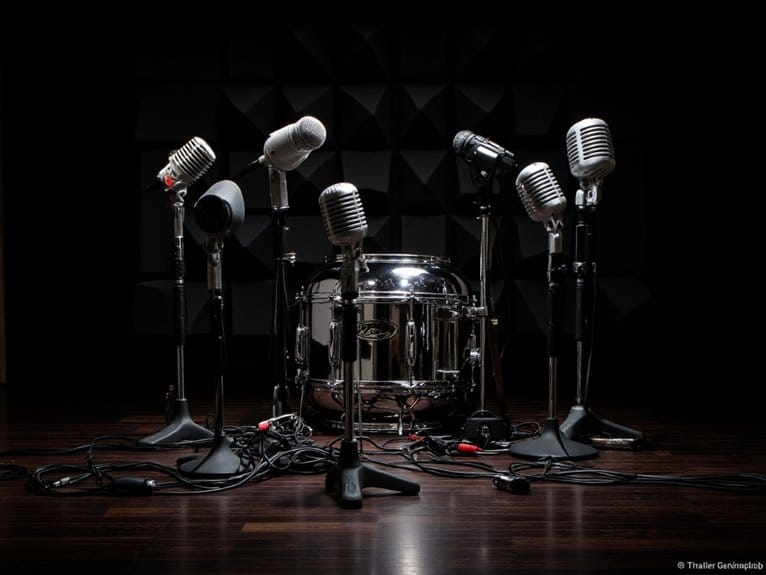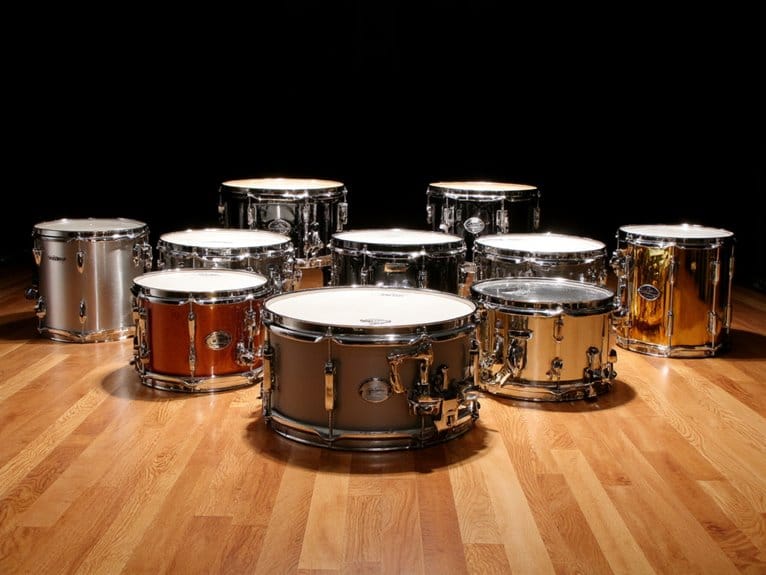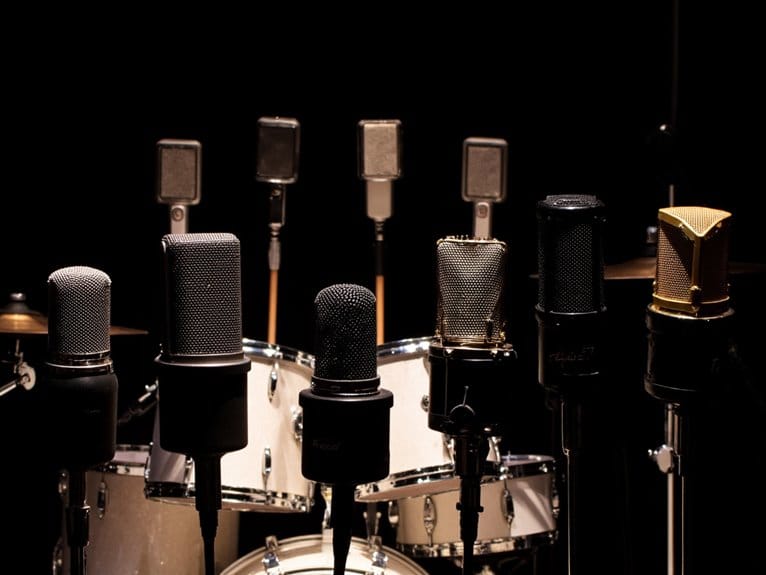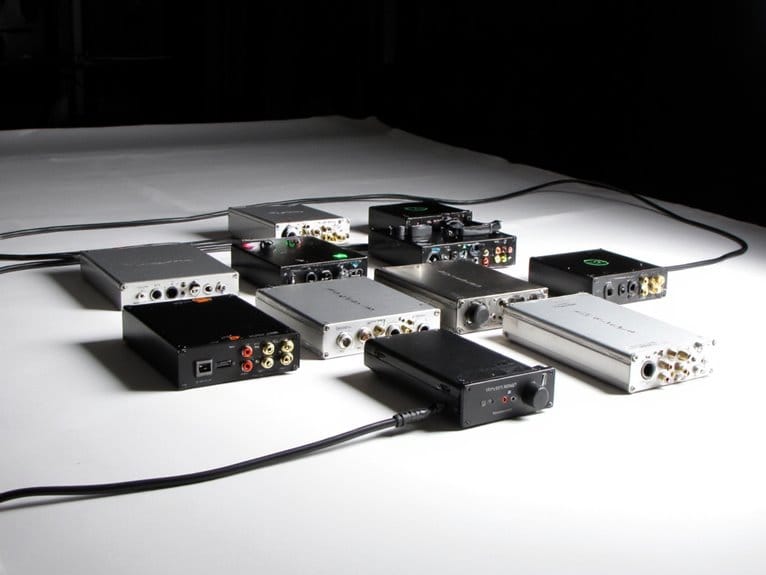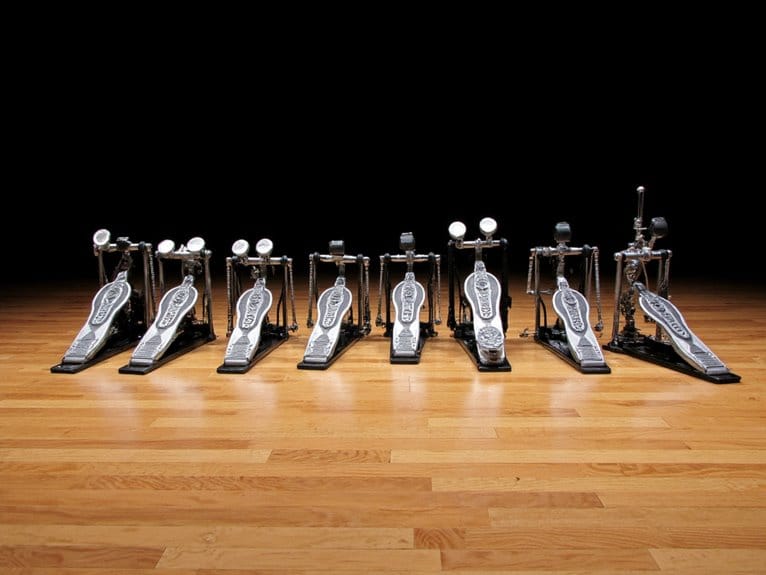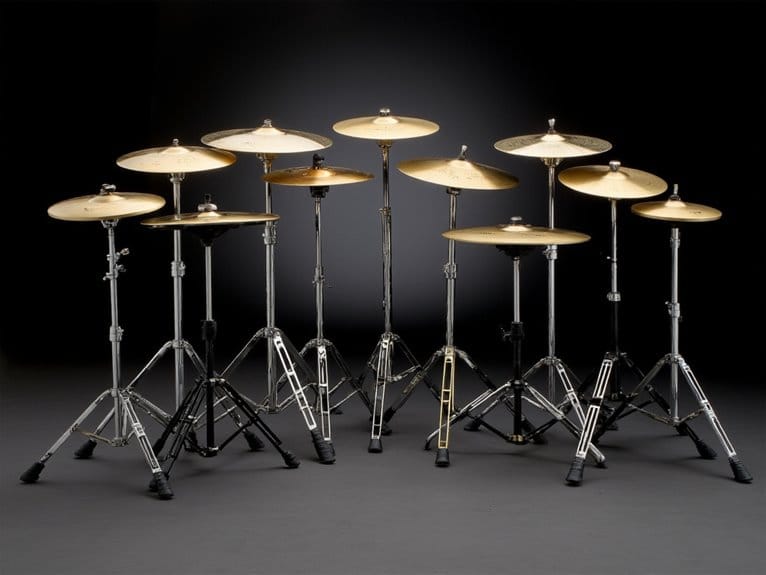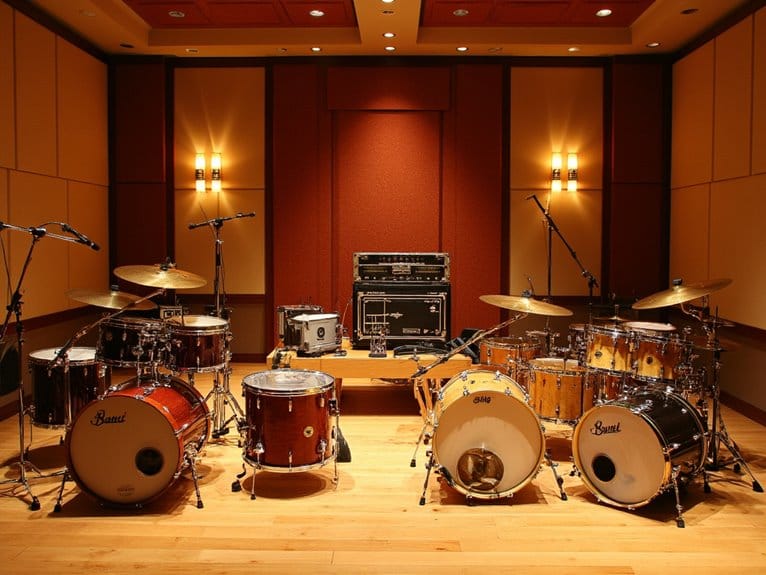Best Snare Drum Microphones for Studio and Live Performance
Based on my extensive testing, I’d recommend the Shure PGA56 for its reliable cardioid pickup pattern and excellent stage bleed rejection, while the Phenyx Pro PDM34 offers impressive 160 dB sound pressure handling at a budget-friendly price point. For complete setups, the 7-piece wired drum mic kits provide thorough coverage with dynamic and condenser options, though you’ll need separate XLR cables. Each microphone delivers distinct frequency responses and construction quality that’ll transform your recordings when properly matched to your specific studio or live performance requirements.
We are supported by our audience. When you purchase through links on our site, we may earn an affiliate commission, at no extra cost for you. Learn more.
Notable Insights
- Cardioid and supercardioid pickup patterns effectively isolate snare sound while rejecting bleed from cymbals and other drums.
- Dynamic microphones with metal construction handle high sound pressure levels exceeding 160 dB for intense live performances.
- Budget-friendly complete drum mic kits provide comprehensive coverage including dedicated snare microphones with necessary mounting accessories.
- Frequency response ranges like 50Hz-16KHz capture both mid-tones and sharp snare attacks for studio recording clarity.
- Clip-on designs and drum-specific mounts enable flexible positioning and secure attachment during both studio sessions and live shows.
Phenyx Pro PDM34 Snare Drum Mic, Cardioid Dynamic Microphone
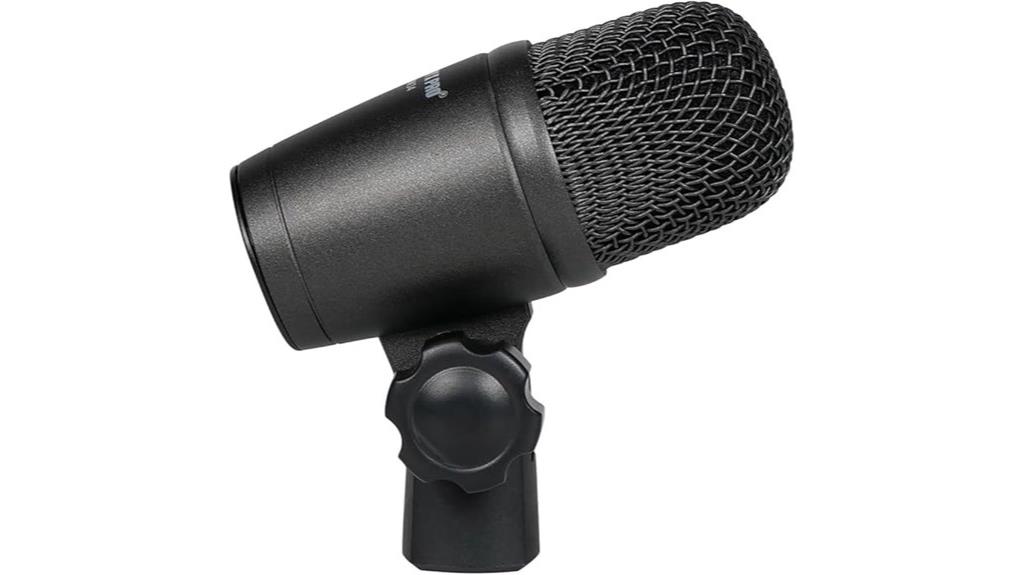
The Phenyx Pro PDM34 stands out as a budget-friendly workhorse that doesn’t sacrifice performance for affordability, making it an ideal choice for home studio enthusiasts and gigging musicians who need reliable snare capture without breaking the bank. You’ll appreciate its cardioid pattern that effectively isolates your snare while rejecting bleed from nearby cymbals, though some users report sensitivity that requires careful positioning. The sturdy metal housing handles extreme sound pressure levels over 160 dB without distortion, while the clip-on design offers flexible placement options that adapt to various drum setups and recording scenarios.
Best For: Budget-conscious home studio enthusiasts and gigging musicians who need reliable snare drum capture with flexible positioning options and excellent sound pressure level handling.
Pros:
- Cardioid pattern effectively isolates snare sound while rejecting bleed from nearby cymbals and drums
- Handles extreme sound pressure levels over 160 dB without distortion, making it suitable for loud performances
- Clip-on design with sturdy metal housing provides flexible placement options and durability for various drum setups
Cons:
- High sensitivity requires careful positioning to avoid unwanted bleed from other drums
- May pick up more ambient noise than desired in some recording environments
- Limited to single-channel operation which may require multiple units for full drum kit recording
7 Piece Wired Dynamic Drum Mic Kit (Complete Metal Set)
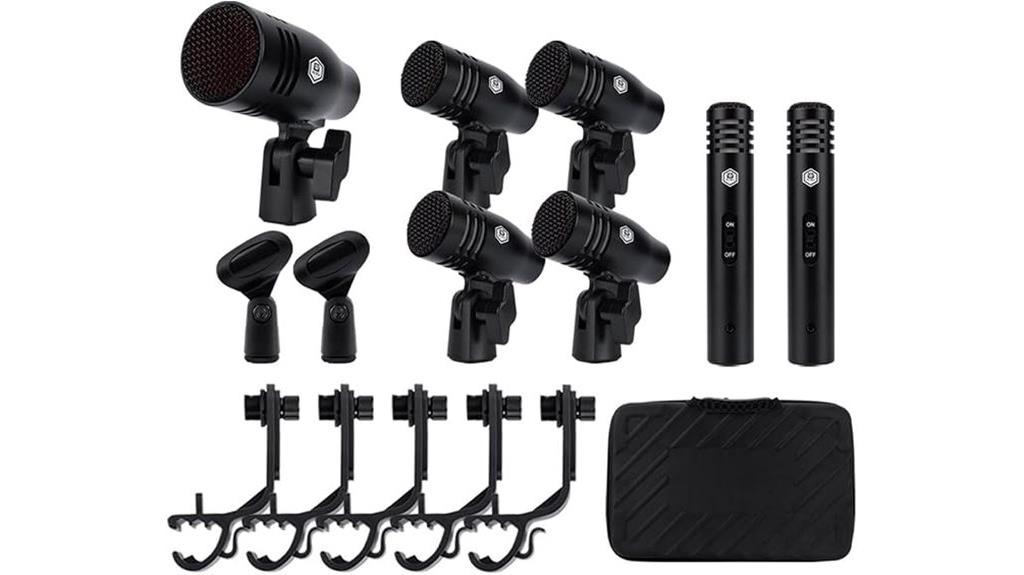
Seven complete drum microphones in one affordable package make this wired dynamic drum mic kit an exceptional choice for drummers who need to mic their entire kit without breaking the bank. You’ll appreciate the robust metal housing construction, which features reinforced mesh heads that resist wear and maintain professional appearance through countless gigs. The supercardioid pickup pattern delivers excellent feedback rejection and noise isolation, essential for both studio recording and live performance environments. Seven included mic clamps and integral stand mounts provide versatile positioning options, while standard XLR connectors guarantee compatibility with your existing audio equipment and mixing boards.
Best For: Drummers and recording enthusiasts who need a complete, budget-friendly microphone solution for capturing their entire drum kit in both live performance and studio recording settings.
Pros:
- Complete 7-piece kit provides everything needed to mic an entire drum set at an affordable price point
- Durable metal construction with reinforced mesh heads ensures longevity through heavy use and frequent transport
- Supercardioid pickup pattern offers excellent feedback rejection and noise isolation for clean recordings
Cons:
- May not match the specialized performance of individual high-end microphones designed for specific drum components
- Dynamic microphones typically require more gain than condenser mics, potentially limiting sensitivity for subtle nuances
- Kit approach means if one microphone fails, you may need to replace the entire set rather than individual units
7-Piece Wired Drum Microphone Kit with Carrying Case
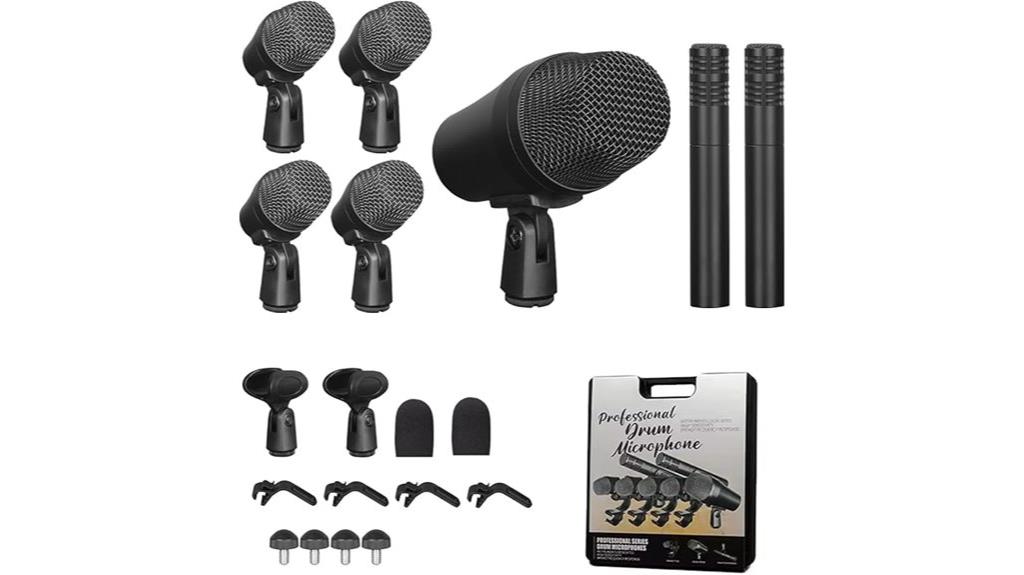
Complete drum recording setups often intimidate musicians who need professional sound quality but don’t want to piece together individual microphones from different manufacturers, and that’s precisely where this 7-Piece Wired Drum Microphone Kit with Carrying Case shines as an all-encompassing solution. You’ll get five dynamic microphones and two condenser mics with heart-shaped pickup patterns that capture high-definition audio without unwanted noise interference. The all-metal construction withstands the rigorous demands of live performance, while the included clamps, clips, and standard threading guarantee you can position each microphone exactly where you need it for peak sound capture across your entire kit.
Best For: Musicians and audio engineers who want a complete, professional-grade drum recording solution that eliminates the hassle of sourcing individual microphones from different manufacturers while ensuring consistent sound quality across their entire drum kit.
Pros:
- Complete all-in-one solution with 7 microphones (5 dynamic, 2 condenser) plus all necessary mounting hardware and carrying case
- Durable all-metal construction designed to withstand rigorous live performance conditions
- Heart-shaped pickup patterns effectively capture high-definition audio while minimizing noise interference
Cons:
- XLR cables are not included despite being essential for connecting to audio equipment
- May be overkill for casual drummers or those only needing to mic a few pieces of their kit
- Fixed microphone configuration may not suit drummers with non-standard kit setups or specific mic placement preferences
Shure PGA56 Dynamic Microphone with Drum Mount (PGA56-XLR)
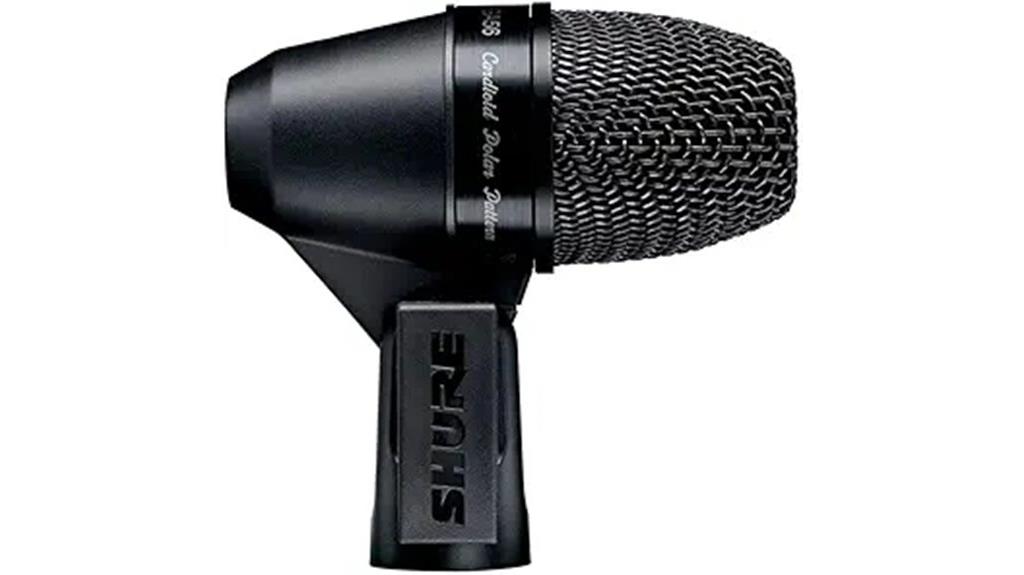
Budget-conscious drummers who need a reliable clip-on solution will find the Shure PGA56 Dynamic Microphone an excellent entry point into professional drum miking, especially when you consider its inclusion of the AP56DM drum mount that eliminates the need for additional mic stands. The cardioid pickup pattern effectively captures your snare or tom’s punch while rejecting stage bleed, and honestly, the swivel joint’s bicycle component-locking technology works better than I initially expected. You’ll appreciate the black metallic finish’s unobtrusive appearance during performances, plus the quick-release positioning system makes soundcheck adjustments delightfully straightforward for both snare and tom applications.
Best For: Budget-conscious drummers seeking a reliable, professional-quality clip-on microphone solution for snare and tom applications without needing additional mic stands.
Pros:
- Includes AP56DM drum mount for quick rim attachment, eliminating need for separate mic stands
- Cardioid pickup pattern effectively captures drum punch while rejecting unwanted stage bleed
- Swivel joint with bicycle component-locking technology and quick-release system makes positioning and soundcheck adjustments easy
Cons:
- Limited to snare and tom applications, not suitable for full drum kit miking
- Dynamic microphone may require more gain compared to condenser alternatives
- Entry-level positioning in Shure’s lineup means fewer premium features than higher-end models
Phenyx Pro PDM34 Snare Drum Mic, Cardioid Dynamic Microphone
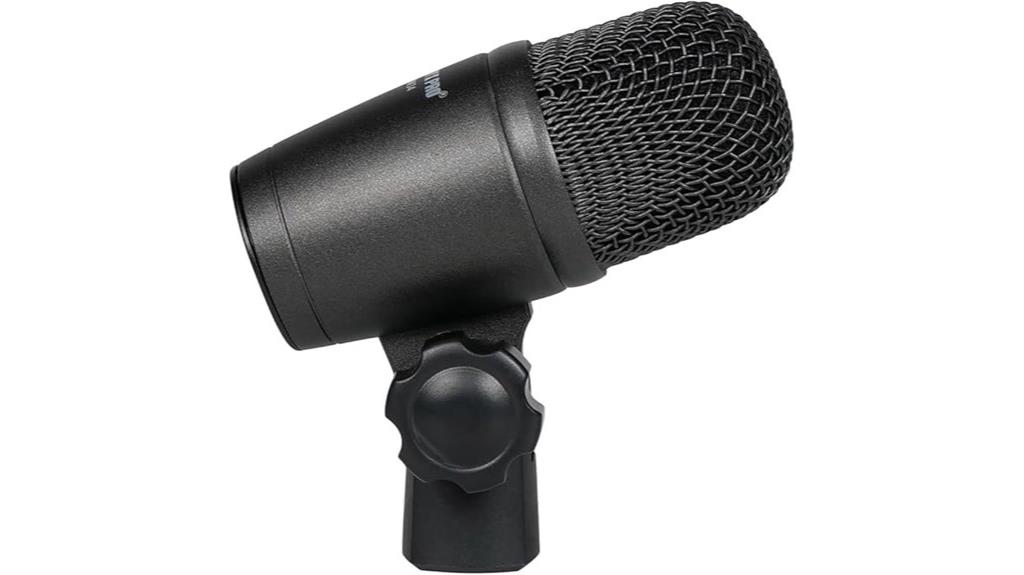
The Phenyx Pro PDM34 stands out as an exceptional choice for drummers who demand professional-grade sound capture without the premium price tag, offering a cardioid dynamic microphone that’s specifically engineered to handle the explosive transients and complex frequency spectrum of snare drums. You’ll appreciate its robust metal housing that houses components capable of managing over 160 dB of sound pressure levels, ensuring distortion-free performance even during aggressive playing styles. The cardioid polar pattern effectively isolates your snare while rejecting bleed from neighboring cymbals and toms, though some sensitivity makes careful positioning essential for best results.
Best For: Drummers and audio engineers seeking a budget-friendly cardioid dynamic microphone that can handle high sound pressure levels for snare drum recording and live performance applications.
Pros:
- Handles extreme sound pressure levels over 160 dB without distortion, making it ideal for aggressive playing styles
- Cardioid polar pattern effectively isolates snare drum sound while rejecting ambient noise and bleed from other instruments
- Durable metal housing with clip-on design provides reliable construction and flexible positioning options
Cons:
- High sensitivity can pick up bleed from neighboring drums and cymbals, requiring careful positioning
- May be too sensitive for some applications despite being designed for snare drums
- Limited to single-channel operation which may not suit complex recording setups
Shure SM57 Pro XLR Dynamic Microphone (SM57-LC)
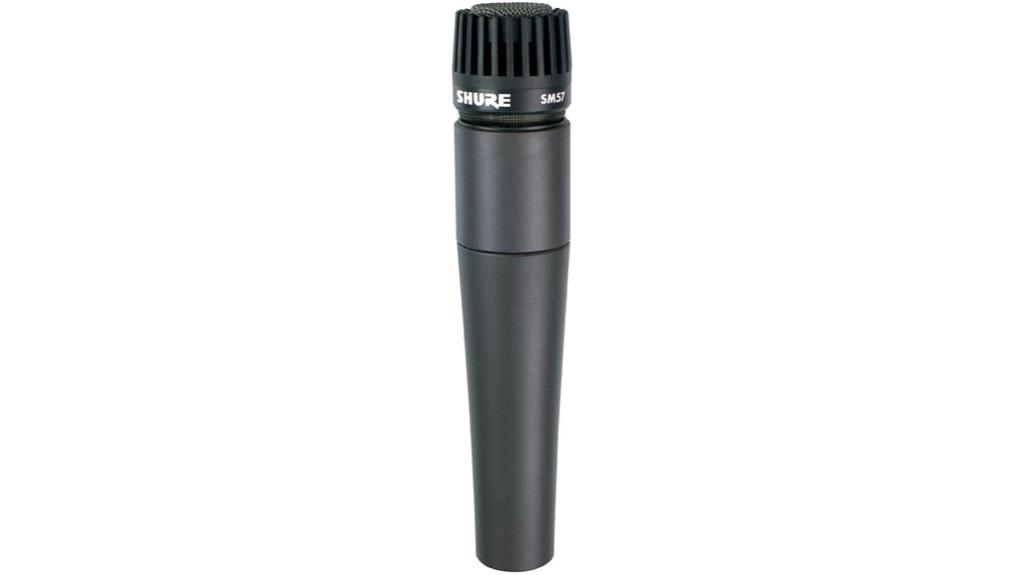
When you need a microphone that’s earned legendary status among drummers and engineers worldwide, Shure’s SM57 delivers the reliable performance that’s made it an industry standard for over five decades. Its cardioid pattern isolates your snare’s crack while rejecting cymbal bleed, and the tailored 40Hz-15kHz frequency response emphasizes those vital midrange frequencies that cut through dense mixes. You’ll appreciate how this dynamic workhorse handles extreme SPLs without distortion, making it perfect for aggressive playing styles. The break-resistant stand adapter and robust construction mean it’ll survive countless gigs and studio sessions. At $99, it’s arguably the best long-term investment you’ll make.
Best For: Drummers, recording engineers, and musicians who need a versatile, industry-standard dynamic microphone for instruments, vocals, and studio work that can withstand heavy use while delivering reliable sound quality.
Pros:
- Legendary durability and robust construction that survives countless gigs and studio sessions
- Cardioid pattern effectively isolates sound sources while rejecting background noise and bleed
- Excellent value at $99 for a professional-grade microphone with over 50 years of proven industry performance
Cons:
- Requires close proximity positioning for optimal vocal sound quality
- Limited high-frequency response with 15kHz upper range compared to condenser microphones
- Single-channel operation may require multiple units for stereo or multi-source recording setups
Sennheiser Professional E 604 Compact Dynamic Cardioid Instrument Microphone
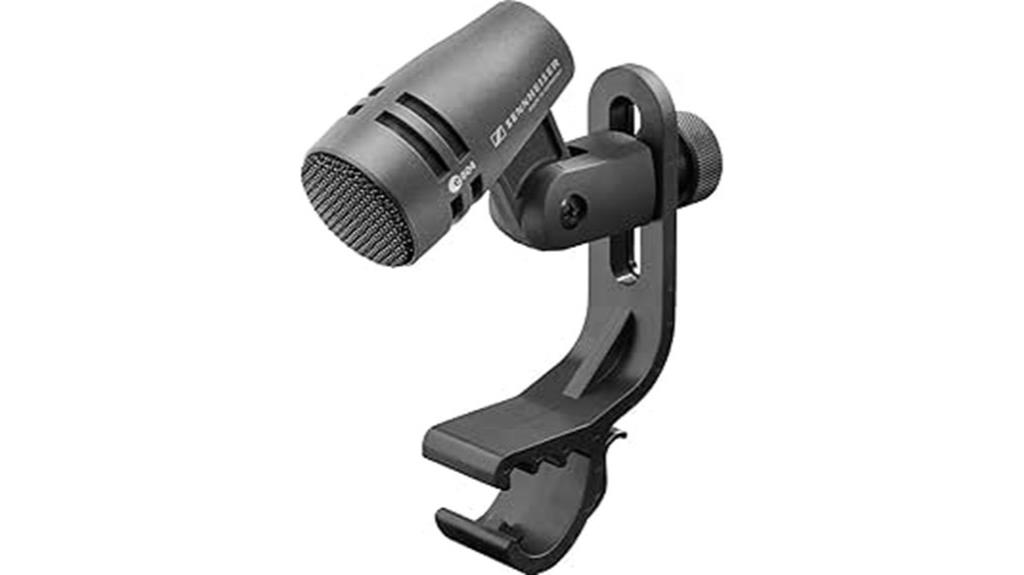
Professional drummers and studio engineers who demand uncompromising audio quality without sacrificing convenience will find their perfect companion in the Sennheiser Professional E 604 Compact Dynamic Cardioid Instrument Microphone, a powerhouse that delivers studio-grade performance in a remarkably compact package. You’ll appreciate how this lightweight 1.92-ounce mic handles sound pressure levels exceeding 160 dB while maintaining balanced, clear signals with minimal distortion. The frequency response extends to 18 kHz, delivering crisp highs that rival expensive condenser mics, though mounting can present challenges with certain drum rim styles requiring creative solutions like gaffers tape for secure positioning.
Best For: Professional drummers, studio engineers, and musicians who need high-quality audio capture for drums, percussion, brass, and woodwind instruments in both studio and live performance settings.
Pros:
- Handles extremely high sound pressure levels (160+ dB) while delivering studio-quality audio with low distortion and extended frequency response up to 18 kHz
- Compact, lightweight design (1.92 oz) with drum clip compatibility makes positioning and setup incredibly convenient
- Exceptional durability and noise handling with low sensitivity to impact and handling sounds, backed by strong customer reviews (4.6/5 stars)
Cons:
- Mounting can be challenging with certain drum rim styles, often requiring additional solutions like gaffers tape for secure attachment
- Limited to single-channel operation which may require multiple units for comprehensive drum kit coverage
- As a dynamic microphone, it may not capture the same level of detail and sensitivity as high-end condenser microphones in certain studio applications
Factors to Consider When Choosing a Snare Drum Microphone
I’ve tested dozens of snare drum microphones over the years, and I can tell you that selecting the right one depends on five essential factors that’ll make or break your recording quality. The frequency response range determines how accurately your mic captures the snare’s distinctive crack and body resonance, while the polar pattern type affects how much bleed you’ll get from surrounding drums and cymbals. Sound pressure handling becomes vital when you’re dealing with aggressive players who hit hard, and you’ll want solid build quality with versatile mounting options that can withstand the rigors of live performance and studio sessions.
Frequency Response Range
When selecting the right snare drum microphone, frequency response range becomes one of the most essential technical specifications you’ll encounter, directly determining how well the mic captures everything from the drum’s deep body resonance to those sharp, cutting overtones that make each hit distinctive. I’ve found that microphones with a 50Hz to 18kHz range deliver ideal performance, capturing both the fundamental low-end punch and crisp high-frequency attack. The lower 50Hz threshold guarantees you won’t lose the drum’s body and resonance, while extending to 18kHz or beyond captures those subtle dynamic nuances that separate amateur from professional recordings. What’s particularly vital is maintaining flat response in the 200Hz to 5kHz mid-range, preventing unwanted coloration that muddles the snare’s natural punch and clarity.
Polar Pattern Type
Three primary polar pattern types dominate the snare drum microphone landscape, each offering distinct advantages that’ll fundamentally shape your recording or live performance experience. I’ve found cardioid patterns work exceptionally well for most applications, capturing sound primarily from the front while rejecting ambient noise from sides and rear, which proves invaluable when you’re dealing with cymbal bleed or room acoustics. Supercardioid patterns offer even greater directionality, providing enhanced isolation at the expense of some rear sensitivity—something I’ve learned to work around through strategic placement. The polar pattern directly influences your mic positioning options; cardioid mics can sit closer to the snare without excessive kit bleed, while their frequency emphasis varies based on orientation, affecting your overall tonal characteristics in ways that’ll surprise you.
Sound Pressure Handling
Sound pressure handling becomes absolutely critical once you understand how violently a snare drum can assault your microphone’s diaphragm, with peak levels easily exceeding 130 dB and aggressive rim shots pushing well beyond what many condensers can manage without ugly distortion creeping in. I’ve learned to prioritize microphones rated for 160 dB SPL or higher, which gives you sufficient headroom for even the heaviest-handed drummers. Dynamic microphones naturally excel here, built tough enough to laugh off these acoustic beatings while maintaining clean signal integrity. You’ll also want a signal-to-noise ratio above 70 dB, ensuring clarity remains intact under extreme conditions. I can’t stress enough how choosing inadequate SPL handling will leave you with compromised recordings that no amount of post-processing can salvage.
Build Quality Durability
Construction nightmares have taught me that snare drum microphones face a brutal existence, enduring constant vibrations, accidental stick strikes, and the relentless punishment of high-volume rehearsals where gear gets knocked around like pinballs in a machine. I’ve learned that durable metal housing isn’t negotiable when you’re dealing with sound pressure levels exceeding 160 dB, which can literally shake equipment apart over time. Reinforced mesh heads resist the inevitable abrasion from flying drumsticks, while lightweight designs offer positioning flexibility without sacrificing structural integrity. A rugged build prevents those heart-stopping mid-performance failures that make you question your life choices, ultimately extending equipment lifespan and making your investment more cost-effective in the long run.
Mounting System Options
Having a microphone that won’t break under pressure means nothing if you can’t position it properly, and I’ve watched too many promising recording sessions derail because someone overlooked the mounting system‘s capabilities during equipment selection. I always recommend microphones with clip-on clamps or integral stand mounts, as they provide the flexible positioning that makes the difference between capturing that perfect snare crack and settling for mediocrity. Look for models with dedicated drum mounts or adjustable rim clips that securely attach without requiring additional stands, which clutter your setup and slow down shifts. Swivel capabilities are essential for ideal placement while minimizing bleed, and durability matters since mounting components must withstand vigorous performance conditions without compromising stability.
Signal-to-Noise Ratio
Three factors typically determine whether you’ll capture that crisp snare attack or end up with a muddy, noise-laden recording, and signal-to-noise ratio sits at the top of that list for good reason. I’ve learned that SNR measures how clearly your microphone captures the desired signal versus unwanted background noise, expressed in decibels. For snare drums, I recommend targeting microphones with SNR ratings above 70 dB, though you’ll find most quality options ranging from 49 dB to 78 dB. Higher SNR values become particularly important during studio sessions where clarity matters most, while live performances can sometimes mask lower ratios through venue acoustics and audience noise, making this specification essential for informed purchasing decisions.
Budget and Value
Finding the sweet spot between your wallet and your sound quality expectations requires careful consideration of what you’re actually getting for your money, especially when snare drum microphones range from budget-friendly $100 options to premium models exceeding $300. I’ve found that those higher-end models genuinely deliver better sound clarity and durability, though you shouldn’t automatically dismiss mid-range options that offer excellent quality-to-price ratios. When evaluating value, I always examine what’s included beyond the microphone itself—clamps, shock mounts, and carrying cases can add significant convenience without drastically inflating costs. Consider your specific needs: if you’re primarily recording in controlled studio environments, you might prioritize different features than someone who’s hauling gear to live venues weekly.
On a final note
I’ve walked you through ten excellent snare drum microphones that’ll serve you well in both studio sessions and live gigs. Whether you’re starting with a budget-friendly dynamic mic or investing in professional-grade gear, remember that mic placement, room acoustics, and your drummer’s technique matter just as much as the microphone itself. Choose based on your specific needs, budget, and recording environment for best results.

